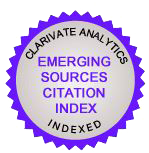Eurythmy: music and movement in Andrei Bely’s poetry
DOI:
https://doi.org/10.30827/meslav.vi20.23543Abstract
The purpose of this article is an attempt to interpret individual fragments from the poems of Andrei Bely, which will be based on certain phonosemantic theories presented by the poet in his theoretical works, as well as in his cult poem about the sound called "Glossolalia", which we will pay special attention to. Referring to the memoirs of Bely's contemporaries and to the autobiographical texts of the poet himself, we will show the great influence that Rudolf Steiner had on the Russian thinker with his anthroposophical teachings in the field of mystical symbolism and eurythmy. The era of the beginning of the XX century is known not only for its versatile research in the field of expanding consciousness but also for the work of many authors on creating a new sensibility, a new art, and a new human. In this regard, we tried to consider some of the author's works.
Downloads
References
Belyj, A. (1982). Vospominanija o Shtejnere. Paris: La Presse Libre.
Belyj, A. (2002). Glossolalija. Pojema o zvuke. Moskva: evidentis.
Belyj, A. (1989). Na rubezhe dvuh stoletij (Serija literaturnyh memuarov). Moskva: Hudozhestvennaja literatura.
Belyj, A. (2010). Simvolizm. Kniga statej. Moskva: Izdatel›stvo «Kul›turnaja revoljucija»; Izdatel›stvo «Respublika».
Belyj, A. (1990). Sochinenija v dvuh tomah. t. 1. Moskva: Hudozhestvennaja literatura.
Belyj, A. (2009). Bezrukaja tancovshhica. Publikacija E.V. Gluhovoj, D.O. Torshilova. Literary Calendar: the Books of Days, 5 (2), 5–25.
Berberova, N. (1996). Kursiv moj. Moskva: Soglasie
Kandinski, V. (2015). Plavi јahach. Izabrani radovi iz teoriјe umetnosti. Preveli s ruskog Љ. Јoksimoviћ, A. Miћiћ, R. Bozhiћ. Beograd: LOGOS.
Krejd, V. (sost.) (1993). Vospominanija o serebrjanom veke. Moskva: Izdatel›stvo «Respublika».
Pajman, A. (2000). Istorija russkogo simvolizma. Avtorizovannyj perevod s angl. V.V. Isakovich. Moskva: Respublika.
Белый, А. (1982). Воспоминания о Штейнере. Paris: La Presse Libre.
Белый,А. (2002). Глоссолалия. Поэма о звуке. Москва: evidentis.
Белый, А. (1989). На рубеже двух столетий (Серия литературных мемуаров). Москва: Художественная литература.
Белый, А. (2010). Символизм. Книга статей. Москва: Издательство «Культурная революция»; Издательство «Республика».
Белый,А. (1990). Сочинения в двух томах. т. 1. Москва: Художественная литература.
Белый, А. (2009). Безрукая танцовщица. Публикация Е.В. Глуховой, Д.О. Торшилова.Literary Calendar: the Books of Days, 5 (2), 5–25.
Берберова,Н. (1996). Курсив мой. Москва: Согласие
Кандински,В. (2015). Плави јахач. Изабрани радови из теорије уметности. Превели с руског Љ. Јоксимовић, А. Мићић, Р. Божић.Београд: ЛОГОС.
Крейд, В. (сост.) (1993). Воспоминания о серебряном веке. Москва: Издательство «Республика».
Пайман, А. (2000). История русского символизма. Авторизованный перевод с англ. В.В. Исакович. Москва: Республика.
Downloads
Published
How to Cite
Issue
Section
License
Copyright (c) 2021 Mundo Eslavo

This work is licensed under a Creative Commons Attribution-NonCommercial-ShareAlike 4.0 International License.

CC BY-SA: This license allows reusers to distribute, remix, adapt, and build upon the material in any medium or format, so long as attribution is given to the creator. The license allows for commercial use. If you remix, adapt, or build upon the material, you must license the modified material under identical terms.
CC BY-SA includes the following elements:
BY ![]() – Credit must be given to the creator
– Credit must be given to the creator
SA ![]() – Adaptations must be shared under the same terms
– Adaptations must be shared under the same terms
Authors who publish with this journal agree to the following terms:
1. Authors retain copyright and grant the journal right of first publication with the work simultaneously licensed under a Creative Commons Attribution License that allows others to share the work with an acknowledgement of the work's authorship and initial publication in this journal.
2. Authors are able to enter into separate, additional contractual arrangements for the non-exclusive distribution of the journal's published version of the work (e.g., post it to an institutional repository or publish it in a book), with an acknowledgement of its initial publication in this journal.
3. Authors are permitted and encouraged to post their work online (e.g., in institutional repositories or on their website) prior to and during the submission process, as it can lead to productive exchanges, as well as earlier and greater citation of published work (See The Effect of Open Access).













